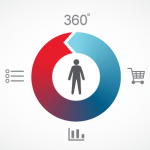It’s difficult to predict with any degree of certainty how consumers will behave over the holiday shopping period or at any time, for that matter. Consumers have different needs and preferences – needs and preferences that constantly change over time or as a result of shifting circumstances (employment status, recent out-of-pocket medical expenses, etc.).
 As Anthony Ginn points out in a blog post for SteelHouse, lumping people into one category based on their incomes or one particular attribute doesn’t make sense.
As Anthony Ginn points out in a blog post for SteelHouse, lumping people into one category based on their incomes or one particular attribute doesn’t make sense.
However, marketers can draw similarities between different sets of consumers when they use data analysis, data discovery and predictive analytics tools to develop a multi-dimensional view of customers based on a range of traits.
In addition to income, retailers can also examine a customer’s lifecycle status (family dynamics and ages), known interests based on recent shopping behaviors, as well as geography.
Companies can also look at feedback that’s been shared by customers through post-transaction surveys, contact center interactions, and social media posts about brands and preferences. When taken together, these attributes can reveal quite a bit about anticipated consumer behavior.
Analyzing consumer behavior during the previous holiday season can also reveal important insights that retailers can use to shape offers. For instance, a multichannel retailer may discern through data discovery that an online promotion for a particular line of fragrances at a 20% discount in December 2011 led to a 16% conversion rate.
However, predictive analytics may reveal that if the retailer were to increase the discount to 25% in the current season, it could expect a conversion rate of 24% while continuing to meet an acceptable profit level.
Analyzing a consumer’s previous behavior can help predict his future behavior.
For example, let’s say that last November a high-value male customer (married with two teenage children) responded to an offer by an electronics retailer for a 55-inch plasma high-definition television. Chances are pretty good that this same consumer is not in the market for a comparably-sized plasma TV again this holiday season.
And further analysis of a post-transaction survey the customer fills out, as well as using predictive analytics tools to analyze the customer’s recent transactions, may reveal that this holiday season he might be a candidate for a home entertainment sound system to complement the plasma TV, especially if it’s offered within a certain price range.
Retailers can also learn quite a bit about consumer behavior by obtaining timely feedback customers share with their frontline employees.
For instance, a sporting goods retailer develops a discounted offer for customers who purchase a combination of cold weather tops and leggings. However, sales of the combination packs don’t move as briskly as expected.
Conversations between customers who examine but ultimately don’t purchase the combination packs and the retailer’s sales associates reveal that most customers would rather purchase individual tops or sets of leggings at slightly higher discounted rates rather than full sets of cold weather gear.
Retailers that canvas their frontline employees can also gather valuable insights that they can act on quickly.





